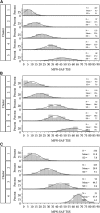Distinct clustering of symptomatic burden among myeloproliferative neoplasm patients: retrospective assessment in 1470 patients
- PMID: 24553173
- PMCID: PMC4067502
- DOI: 10.1182/blood-2013-09-527903
Distinct clustering of symptomatic burden among myeloproliferative neoplasm patients: retrospective assessment in 1470 patients
Abstract
Symptom burden in myeloproliferative neoplasms (MPNs) is heterogeneous even among patients within the same MPN diagnosis. Using cluster analysis from prospectively gathered symptom burden data in 1470 international patients with essential thrombocythemia (ET), polycythemia vera (PV), or myelofibrosis (MF), we assessed for the presence of clusters and relationship to disease features and prognosis. In MF (4 clusters identified), clusters significantly differed by Dynamic International Prognostic Scoring System (DIPSS) risk (P < .001), leukopenia (P = .009), thrombocytopenia (P < .001), and spleen size (P = .02). Although an association existed between clusters and DIPSS risk, high symptom burden was noted in some low and intermediate-1-risk MF patients. In PV (5 clusters identified), total symptom score increased across clusters (P < .001), but clusters did not significantly differ by PV risk or the risk assessment variable of age. Among ET patients (5 clusters identified), clusters differed by gender (P = .04), anemia (P = .01), and prior hemorrhage (P = .047). Total symptom score increased across clusters (P < .001), but clusters did not significantly differ by International Prognostic Score for ET risk including the risk assessment variables. Significant symptom heterogeneity exists within each MPN subtype, sometimes independent of disease features or prognosis.
© 2014 by The American Society of Hematology.
Figures
Comment in
-
Symptom burden in hematologic malignancies.Blood. 2014 Jun 12;123(24):3686-7. doi: 10.1182/blood-2014-03-558981. Blood. 2014. PMID: 24926067 No abstract available.
References
-
- Mesa RA, Niblack J, Wadleigh M, et al. The burden of fatigue and quality of life in myeloproliferative disorders (MPDs): an international Internet-based survey of 1179 MPD patients. Cancer. 2007;109(1):68–76. - PubMed
-
- Scherber R, Dueck AC, Johansson P, et al. The Myeloproliferative Neoplasm Symptom Assessment Form (MPN-SAF): international prospective validation and reliability trial in 402 patients. Blood. 2011;118(2):401–408. - PubMed
-
- Mendoza TR, Wang XS, Cleeland CS, et al. The rapid assessment of fatigue severity in cancer patients: use of the Brief Fatigue Inventory. Cancer. 1999;85(5):1186–1196. - PubMed
MeSH terms
Grants and funding
LinkOut - more resources
Full Text Sources
Other Literature Sources



